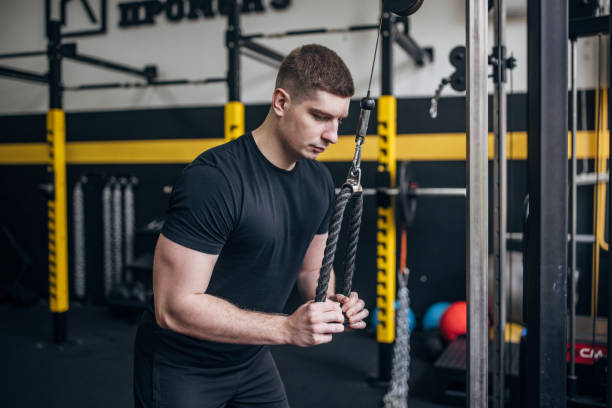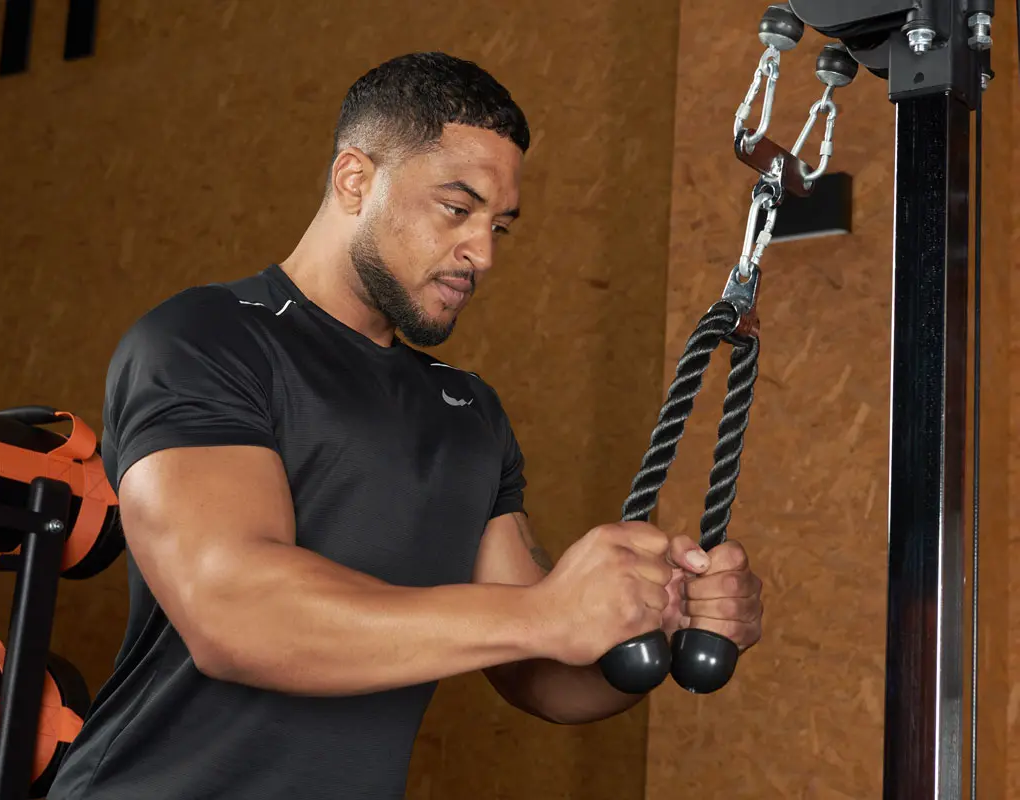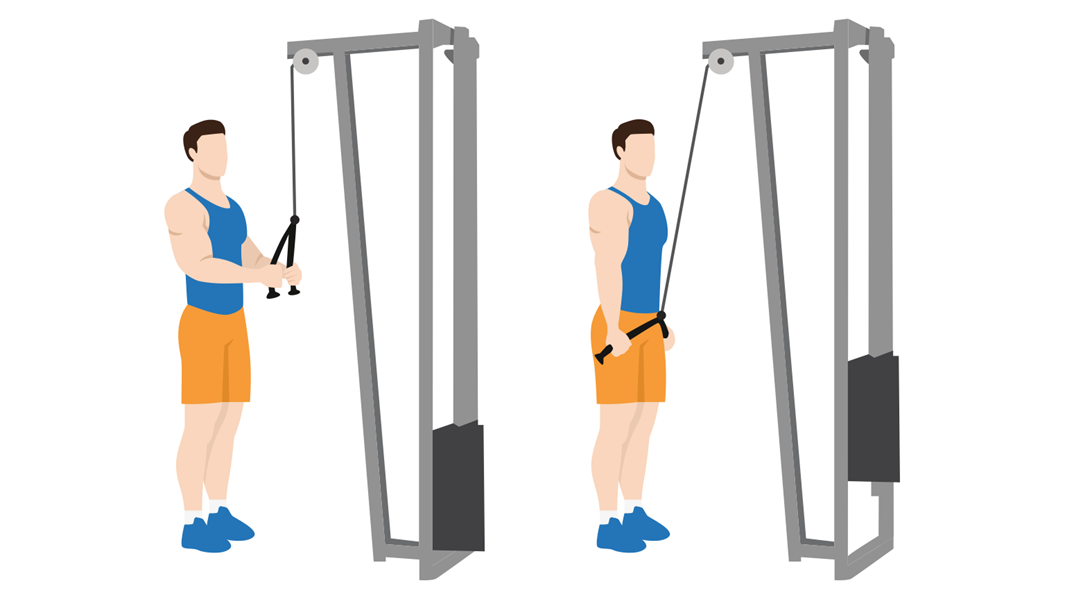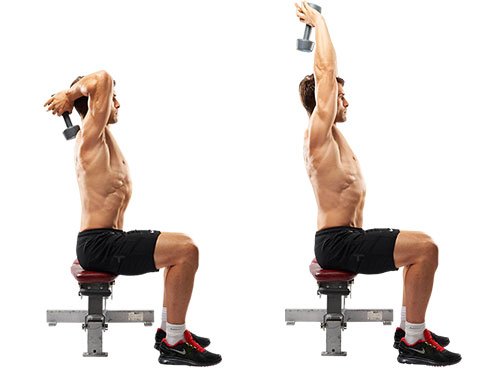Triceps Rope Pushdown: Precision Isolation for Triceps Shape, Density, and Definition
Every bodybuilder knows this movement — the Triceps Rope Pushdown — that satisfying cable finisher that makes your triceps feel like they’re carved from stone.
But don’t let its simplicity fool you. When performed with mastery, this staple isolation exercise can be one of the most effective tools for sculpting triceps shape, enhancing definition, and improving lockout strength.
Unlike pressing compounds or overhead extensions, the rope pushdown targets the lateral and medial heads of the triceps with constant cable tension, allowing for continuous engagement from start to finish.
It’s a movement that’s as much about feel as it is about force — a precision exercise where mind-muscle connection trumps sheer load.
For bodybuilders, it’s often the final touch in a triceps session — the exercise that brings the pump, sharpens detail, and refines the “horseshoe” appearance that separates an average arm from a stage-ready one.
Let’s dive deep into its anatomy, setup, execution, programming, and advanced strategies to turn the humble rope pushdown into a triceps growth engine.
Muscles Worked
Primary:
- Triceps brachii — emphasis on the lateral and medial heads
Secondary:
- Anconeus (stabilizer)
- Forearm flexors (grip and rope control)
- Core and shoulders (postural stability)
👉 The lateral head is the outermost part of the triceps that gives arms their “horseshoe” contour, while the medial head lies deeper, providing density and definition. The rope pushdown targets both with surgical precision.
Why the Rope Pushdown Deserves a Place in Every Arm Routine
- Constant Cable Tension
- Keeps the triceps loaded through the entire movement — no “rest” point at the top or bottom.
- Superior Isolation
- Minimal shoulder involvement — all tension directed into the triceps.
- Elbow-Friendly Mechanics
- Natural wrist rotation reduces joint stress compared to rigid bar attachments.
- Excellent Finisher Movement
- Perfect for flushing the muscle with blood at the end of a session for maximum hypertrophy signaling.
- Shape and Definition Builder
- Accentuates the outer triceps sweep, contributing to that sculpted “horseshoe” aesthetic.
Proper Form: Rope Pushdown Technique
Setup
- Equipment
- Attach a rope handle to the high pulley of a cable station.
- Adjust the weight stack to a moderate resistance — heavy enough to challenge, but light enough to control fully.
- Body Position
- Stand upright or lean slightly forward at the hips.
- Keep feet shoulder-width apart and knees soft.
- Grip the rope with a neutral grip (palms facing each other).
- Bring elbows close to your sides — they stay fixed throughout.
Execution
- Starting Position
- Begin with forearms just above parallel to the floor, elbows pinned in place.
- Engage your core and keep your chest lifted.
- Pushdown Phase (Concentric)
- Exhale and drive the rope down until your arms are fully extended.
- At the bottom, separate the rope ends slightly to externally rotate the wrists — this amplifies triceps contraction.
- Squeeze the triceps hard for a one-second pause.
- Return Phase (Eccentric)
- Inhale as you slowly let the rope rise back to the starting position.
- Maintain tension — don’t let the weight stack slam or your elbows drift forward.
- Repeat
- Maintain control, full range, and a deliberate pace for every rep
Key Form Cues
✅ Keep elbows glued to your sides — they are the pivot, not the movers.
✅ Separate the rope ends at the bottom for peak contraction.
✅ Maintain slight forward lean to keep cable path aligned with forearms.
✅ Avoid using momentum — move smoothly and deliberately.
✅ Keep wrists neutral and controlled throughout.
Common Mistakes and Fixes
| Mistake | Issue | Fix |
| Elbows drifting forward | Turns movement into a press, reduces isolation. | Keep elbows tight to sides and still. |
| Leaning too far over | Reduces triceps tension, engages chest. | Maintain upright posture with slight forward angle only. |
| Using momentum | Decreases muscle control, increases risk of strain. | Slow tempo; squeeze every rep. |
| Not separating the rope | Misses full contraction of lateral head. | Actively spread rope apart at bottom. |
| Locking elbows harshly | Strains joints. | Extend fully but avoid slamming lockout. |
Variations and Equipment Options
- Single-Arm Rope Pushdown
- Ideal for isolating each arm independently and fixing imbalances.
- Bar Pushdown (Straight or EZ-Bar)
- Allows heavier loading; emphasizes overall triceps strength.
- Reverse-Grip Pushdown
- Shifts emphasis to the medial head for improved density.
- V-Bar Pushdown
- Great middle ground between rope and straight bar — more stable, still elbow-friendly.
- Cable Overhead Rope Extension (Reverse Position)
- Same setup, but facing away from the machine for a long-head focus.
Programming Guidelines
For Hypertrophy (Muscle Growth)
- Sets: 3–4
- Reps: 12–15
- Rest: 60–90 seconds
- Tempo: 2 seconds down, 3 seconds up
- Goal: Maximum tension and controlled contraction.
For Strength and Power
- Sets: 4
- Reps: 8–10
- Rest: 90–120 seconds
- Goal: Slightly heavier load with strict form; build pressing lockout strength.
For Pump and Definition
- Sets: 3
- Reps: 15–20
- Rest: 30–45 seconds
- Goal: Metabolic stress and blood flow for finishing a triceps workout.
Integration into Your Program
Example Arm Day
- Close-Grip Bench Press – 4×8
- Skullcrusher – 3×10–12
- Overhead Rope Extension – 3×12
- Triceps Rope Pushdown – 3×15–20
- Cable Curl – 3×15
Example Push Day
- Bench Press – 4×6
- Overhead Press – 3×8
- Incline Dumbbell Press – 3×10
- Rope Pushdown – 4×12–15
- Dumbbell Lateral Raise – 3×15
Finisher Superset
- Rope Pushdown – 15 reps
- Bodyweight Dips – to failure
- (Rest 60 seconds, repeat 3 rounds.)
Advanced Training Strategies
- Pause Reps
- Hold for 2 seconds at the bottom contraction to intensify fiber recruitment.
- Slow Negatives
- 4–5 second eccentrics to increase time under tension.
- 1½ Reps
- Lower halfway up, push down again, then full return — doubles contraction density.
- Drop Sets
- Reduce weight by 20–30% immediately after failure; perform another set without rest.
- Cable Angle Adjustments
- Stepping slightly back or forward changes the resistance curve and recruits different fiber angles.
Bodybuilder’s Tips
💡 Focus on Feel, Not Load: Lighter weights with perfect tension will build more size than swinging heavy stacks.
💡 Separate at the Bottom: Don’t just push — spread. That’s where the rope variation shines.
💡 Keep Tension Constant: Never let the stack rest; continuous load keeps fibers activated.
💡 Superset It: Pair with skullcrushers or dips for complete triceps exhaustion.
💡 Train Toward the End of Your Session: It’s best as a finisher after heavier presses or extensions.
Strength vs Aesthetics
| Focus | Style | Benefits |
| Strength | Heavier weight, 8–10 reps | Builds lockout power and compound press carryover |
| Aesthetics | Moderate load, 12–15 reps | Maximizes shape, definition, and pump |
| Endurance / Conditioning | High reps (15–20+), minimal rest | Improves vascularity and metabolic stress |
Safety and Joint Health
- Always control both the up and down phases — jerking damages tendons.
- Avoid overextending the elbows or letting shoulders roll forward.
- Use a neutral wrist position — don’t twist aggressively at the bottom.
- Warm up elbows and wrists with light banded extensions.
- Stretch triceps and forearms after training to maintain mobility.
Practical Takeaways
✅ Keep your elbows stationary — isolation is everything.
✅ Use a neutral grip and smooth tempo for long-term elbow health.
✅ Separate the rope at the bottom for a full triceps contraction.
✅ Incorporate different attachment types to challenge the muscle from new angles.
✅ Use pushdowns as a finisher to maximize pump and definition.
Conclusion
The Triceps Rope Pushdown is far more than a casual cable exercise — it’s the finishing tool that sculpts and defines the triceps like nothing else.
For bodybuilders, it represents precision control: the ability to squeeze, contract, and shape muscle fibers under continuous tension.
Done properly, it delivers both form and function — boosting pressing strength while refining aesthetic detail.
Whether you’re an advanced competitor chasing sharper arm separation or a beginner building foundational tone, the rope pushdown belongs in your arsenal.
Slow it down, lock in your elbows, spread the rope, and feel the triceps ignite. When your arms start to feel like they’re wrapped in fire, that’s not fatigue — that’s growth.




